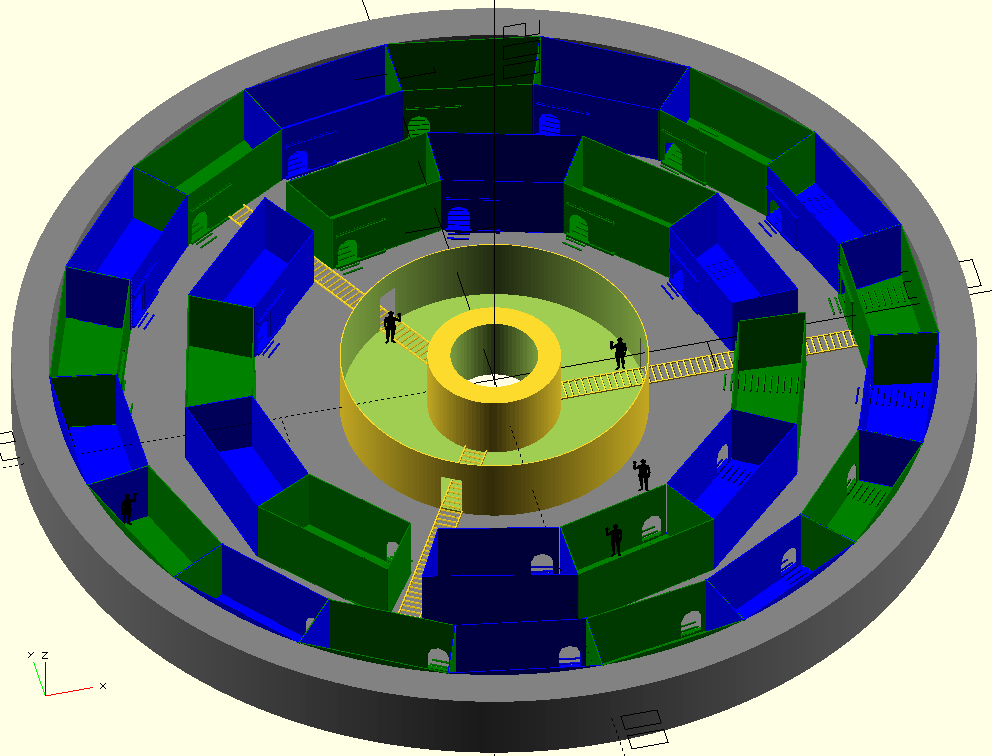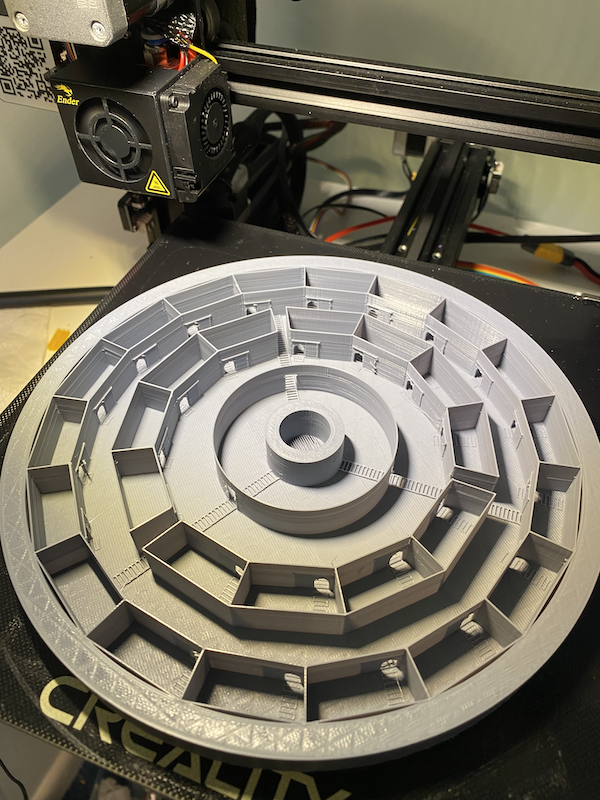I have been working on designs for small starships in my Sublight Universe. The ship is called the Cervantes Class. (Yes a nod to the Rocinante in the Expanse.)
The high concept for the vessel is something about the size of the YT-1300 Stock Light Freighter from the Star Wars Universe. Its wet mass is around that of a Naval Frigate. The class is mass produced by the Internation Space Treaty Organization, and is the workhorse of their fleet. The class has been tweaked several times throughout the decades, and while not anything state of the art the design is so fit for purpose that it carries on despite its limitations. It has also been pressed into roles for which was never originally designed for. Kind of like the C-130 or the Arleigh Burke destroyer.
In my lore, the design was adapted from a popular commercial lighter. The ISTO was mainly concerned with operating costs. After losing its fleet in port during the Solar War it regards the best defense against surprise attack as to keep the fleet constantly in flight. It also decided that speed, maneuverability, and sheer numbers were needed because attempting to concentrate power into a few large capital ships proved disastrous.
The Cervantes is optimized to reduce complexity and manning. The ship has 30 crew, enough to run a 10 man rotation for 3 8 hour shifts. The cabins are spacious enough to be long-term housing. This allows crews to be quartered on the vessel even when in port. This is vitally important because these ships serve on the edge of civilized space, and operate from austere facilities.
The data sheet for my Starship Design Tool is Cervantes Class Frigate.json
The concept is that the ship is the workhorse of the Fleet. It has a crew of about 30, and can operate for 120 days. In that 120 days it can fly from one end of the Asteroid belt to another, a trip of around 9 AU. The Vessels is capable of Earth landings and takeoffs. Partly to defend ISTO in case of Krasnovian invasion from Luna. Mostly to haul people and artifacts off of the Earth relatively cheaply.
The Main Reactor
The Cervantes is powered by an EHI 7200 Series LIDIPEG (Lithium/Deuterium Implosion Propulsor/Electrical Generator). The system uses the thermonuclear implosion of millimeter sized pellets of Lithium Deuteride. The Propulsor uses plasma from the reaction is used to accelerate propellant to a fraction of the speed of light. The Electrical Generator takes the superheated cooling water from that propulsor and uses it to drive a turbine/alternator to produce electrical power.
During the cruise portions of flight the LIDIPEG operates at an "idle" speed, producing very little thrust but a lot of waste heat. Thus giving the ship the appearance that the engine is on the entire time.
The Cervantes has a single LIDIPG. Fusion reactors obey the square/cube law. One big reactor is much much more powerful than two smaller reactors of equivilent size. The 7200 Series resides in an odd corner of the power output/efficiency curve, which is popular for military and commercial vessels alike.
The 7200's popularity is down to being just good enough at everything a small vessel requires. It's the Volkswagon Beetle of reactors.
Handling Breakdowns
While the crew can perform some maintenance and repair, substantial fixes are only possible in a dedicated facility. To reduce downtime, the entire engineering section can be removed as a module. If disabled, the vessel is light enough, and the engines powerful enough, that it can be towed by another vessel of the same class. There are even provisions for the towing ship to draw propellant from the towe-ee's tanks. This is important as the propellant is most of the wet mass of the ship.
Earth Landings/Takeoffs
As a small combatant/utility vessel it was important for the Cervantes to be able to operate from surface facilities on Earth.
The thrust from the ship's engine plant provides a thrust-to-weight ratio sufficient to take off from the surface of the Earth. However environmental regulations prohibit the use of the fusion thruster inside the Troposphere. Unspent tritium contaminates rainwater.
For low-level flight the ship's steam-powered reaction control system (RCS) is used. The RCS uses waste heat from the fusion reactor to produce superheated steam. While the RCS produces a tremendous amount of thrust, it has a very low specific impulse. Atmospheric flight requires a tremendous amount of propellant.
Atmospheric re-entry from orbit requires water-mist cooling of the ship's exterior. The Leidenfrost effect to pushes super-heated plasma away from the skin of the ship. This system requires a non-trivial amount of water. Much water is required for low-level flight to the landing zone using the RCS.
The RCS system for the Cervantes would be entirely overpowered for a vessel that operates only in space. Hoever it's relatively simple technology is cheap and cheerful to build, maintain, and operate. It's inclusion in the Cervantes makes the class extremely maneuverable for their size. The tradeoff is the extra mass in tankage and steam propulsion is less mass that can be used for bulk cargo or other mission equipment.
Artificial Gravity
So, now we get to the interesting bit. We can kind of assume that they would build the ship such that the crew could get around when the vessel is on the ground. If on Earth, the ground provides 1 G. On the moon, 1/6 of a G. And outside of the larger moons of Jupiter and Saturn, much much less.
The engines have enough power to provide 1 G (or more) of constant accelleration. But that much accelleration requires increasingly ridiculous amounts of propellant to maintain. The tyranny of the rocket equation is that you need mass to accelerate mass. Even with a hyper-efficient fusion engine, mass of propellant to push extra propellant adds up quickly. As such, the propulsors on the Cervantes only operate for 6-10 hours to get the ship up to its cruising speed.
The time for a 9 AU trip from one side of the Asteroid belt to another, assuming you are happy with a cruising speed of about 200,000 m/s, is 78 days. These ships would also have to operate while in orbit around larger planetary bodies for weeks or months to perform patrols or surveillance missions. In these conditions, there is no natural gravity and the ship is in free-fall. While a few days of microgravity is fine, months of it requires substantial rehabilitation. Many settlements the crew is likely to operate from won't have dedicated medical facilities.
The only way to provide reliable gravity for a free-falling vessel is through Rotational Gravity. Yes, there are some Tegical effects that can produce temporary gravitational fields, but those are too energy intensive (and have way too many side effects) to rely on long-term.
To cut down on weight, expense, and complexity the Cervantes does not have a dedicated centrifuge section. Instead, the entire vessel spins at approximately 6 rotations per minute. Thus requires some adjustment for the crew. But with a radius of 20 meters, the ship produces about 1/6 gravity on the outer edges of the habitat.
It was found throughout spaceing history that 1/6 of a G is enough to keep a body healthy and prevent most of the more extreme maladaptations the body makes to microgravity. Crews experience some muscle loss, but that can be countered with regular exercise. (Or a few days of light-duty when they get pack to port.)
The vessel could spin faster to produce more gravity, but greater rotational speeds produce disorientating side effects. Increasing the vessel's radius allows it to produce more gravity at a much lower speed. (The 440 meter wide Van Gogh class produces 1 G at 2 rpm.) However, the Cervantes class was designed as a small vessel. As it is, 20 meters in radius is about as small as is possible. Much smaller and the rotation required to produce even lunar gravity gets to be extreme enough to produce debilitation side effects.
While the 6 rpm of the Cervantes requires a little adjusting to, the most profound source of disorientation for the crew comes from the change in direction of gravity between Thrust mode and Rotation mode. Walls become floors, and floors become walls.
Gravity in rotational mode:

Gravity in thrust mode (or when landed on a planet/docked in a larger station):

It is confusing enough that I had produce a 3d print of this setup just to wrap my head around it.

Inspiration
The craft was originally much narrower and taller until I did the calculations for what would be required for rotational gravity. As soon as I solved the volume to be a coin-shaped disk I immediately thought: "Holy Cow, it's a flying saucer!"
I also drew on a few concepts from the following Youtube videos for how the RCS might actually work:
Still to do...
My plan is to have a completely printed 3d model sitting on my desk. Something that can snap apart to show the internals. So I am working up the time to sketch:
- The reactor core
- The upper side if the ship. It's going to have a lot of radiator panels, though I may decide to add an Enterprise-esqu sort of curve to it all.
- The lower structure, which will include most of the piping for the RCS system, the propulsor nozzle, and the landing gear.
- The next print of this is going to include furnishings, and special structures like the airlock, galley, and cargo bay.
Lore Extras
Random thoughts that I want to capture, but which otherwise interrupted the flow of the passages above:
- 7200 for the EHI series 7200 refers to its original rated thrust of 7.2 megawatts. Improvements in technology have pushed the output much higher in modern units.
- Most spacers pronounce LIDIPEG as LID-PEG or LID-PIG.
- Larger (and more survivable) vessels have multiple reactors. Many also have dedicated reactors for propulsion and dedicated reactors for power generation. Purpose built units tend to be more efficient than combined cycle designs like the LIDIPEG.
- A LIDIPEG can only operate for a finite number of hours before they have to be disassembled and refurbished. Much like aircraft engines today.
- A Cervantes has enough tankage to either take off from Earth, or Land on Earth. Doing both requires a refueling in orbit. In normal operations in space, these tanks are:
- kept empty to reduce the mass of the vehicle (cheaper operating costs)
- used to boost the DeltaV of the vessel for long-range missions
- used to refuel other craft if the ship is acting as a tanker
- used to carry bulk water to outlying settlements
- The ISTO operates another class of frigates, the Capricornus, which lacks the atmospheric landing capability. It trades that mass for a more efficient (albiet bulkier) heavy water based reactor/propulsor. As a result it has a much higher effective deltaV, and more cargo/mission capacity. The Cervantes and Capricornus can swap mission modules as they both descend from the same basic design. (Though most spacers put it down to the fact the ISTO are cheapskates.)
- The "Relatively Cheaply" cargo/passenger service is a little misleading. That is "Relatively Cheaply" in military budgetary terms. The sheer expense of boosting mass to Earth orbit makes the mass transport of bulk goods cost prohibitive. People are considered relatively priceless. The goods that a Cervantes takes aloft are generally expensive parts, critical war materials, priceless cultural artifacts, and whiskey. Everything else is cheaper to produce in space.
- And as far as Whiskey goes, the problem comes down to the oak barrels to age the spirits in. While efforts are underway to plant forests in the settlements around the Solar System, oak trees take decades to reach market size. Despite the exorbitant cost, people still love their whiskey. To the point that bottles of it are a form of currency.